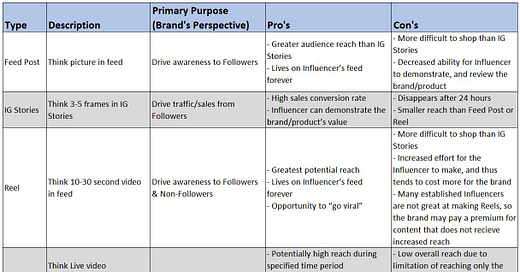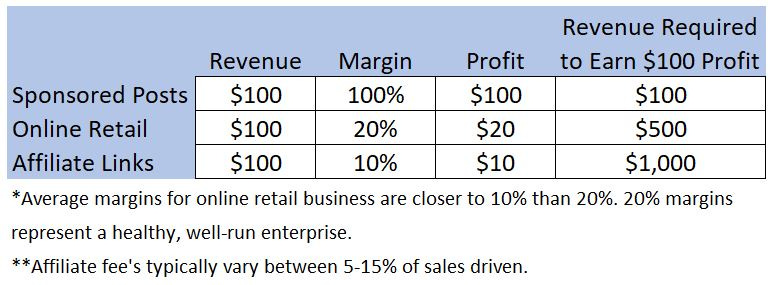Do you prefer listening or reading? Perfect! You can do either! Listen by pressing PLAY button (above), or you are welcome to read on! The content is the same (I read the email to you in the audio version).
If you appreciate me offering an audio option (i.e. you want me to keep doing it), please tell me in the comments. Okay, back to the newsletter!
HAPPY FRIDAY!
Welcome back to the most interesting email of the week! Last week, I promised you a newsletter all about the secrets of Brand Collaborations. Well, the good news is I fully intend on keeping my promise. The even better news is there is so much to share, I’m splitting it into 2 separate newsletters (one this week and one next week). So buckle up because this email is a 10/10 in terms of importance if you want to understand the influencer ecosystem.
So even if you are a large Influencer already (I was both surprised and flattered to see some of your emails in the list), I think you will find the tables, graphics, and frameworks I present quite interesting!
So with no further adieu, let’s jump into the basics of Brand Collaborations!
The Fundamentals: Brand Collaborations (“Collabs”)
Definition:
At its most simple, a brand collaboration is when a brand pays an Influencer to create and post content.
4 Basic Types of Instagram Collabs:
For both the reasons listed in the table above, and for reasons beyond the scope of this particular email, “Story” collaborations are currently the most common type of brand collaboration.
Okay, so now that you’ve studied the table above, you know more about Instagram collaborations than 99% of the known universe (go ahead… give yourself a well-deserved pat on the back) let’s move on to an even more interesting topic! In fact, many would argue its the most interesting topic on earth… Sex.
Just kidding. We’re not going there in this newsletter :)
But we ARE going to talk about the SECOND most interesting topic… Money :)
Influencer Micro-Economics:
There are 3 main questions most of you are wondering:
“How much money do Influencers actually make?”
“How much money could I make if I became an Influencer?”
“How much should I pay the Influencer’s I work with?”
Well, every Influencer is different, and I’m not going to try and tackle the myriad of ways people have found to monetize their Influence in this week’s newsletter. I will say though, YOU WOULD BE AMAZED AT THE THINGS PEOPLE COME UP WITH. If learning more about monetizing Influence is something a lot of you are interested (and no, I’m not talking about fart jars), tell me in the comments. Maybe I can do an email or two on that topic.
But putting that aside, we can get a pretty good idea how much most Influencers are making in what is likely the most profitable part of their business.
Yes, I’m talking about brand collaborations. Brand collaborations are the #1 way most large Influencers make most of their money.
I can already hear some of you thinking “But what about the Influencers who have their own online stores? And what about all those swipe up links they do? Don’t they make more money from those?” Some do… But they are the exception that proves the rule, and you are about to see why.
Let’s throw back to some 6th grade math for this one (shout out to “Mr. P” at Greenhill middle school). Can you solve the problem below? And Spoiler Alert: If you can’t or if you “definitely could if you really wanted to but you are in a hurry,” I provide the answer below :)
Math Question:
Business ABC generates $100 of sales and earns a 15% margin after paying for products, shipping, labor, warehouses, software, product returns, unsold inventory, interest on bank debt, employee health insurance, etc.
Business XYZ generates $100 of sales and earns a 100% margin, plus gets tons of free stuff.
How much would Business ABC need to grow to make as much profit as Business XYZ?
As I’m sure all you brilliant math wizards (and “witches”?) already figured out, the answer is:
Business ABC would need to grow 1,000% (be 10x larger) to earn as much profit as Business XYZ.
Below is a table further illustrating the point:
So now that we comprehend the margins on lean media businesses, let’s talk pricing frameworks and unit economics.
Media Businesses - The 2 Minute Primer:
The Influencer business (Brand Collabs) is basically a scaled down version of the Network TV business, with one very important difference (more on that later).
Below, you will find an extremely simplified version of the Network TV business:
Networks play entertaining content (TV shows)
During the TV show, they air advertising slots (a dozen or so 30-60 second commercials per 30 minute TV slot) which they sell to businesses who want to advertise to the TV show’s audience.
The amount of revenue a Network makes from a TV show season is basically:
[Number of viewers] x [Price per viewer] x [Number of commercials per episode] x [Number of episodes aired] = TV Show Revenue
Illustrative example included in the footnotes below1
If we want to convert this to an annualized Influencer business it would be rewritten:
[Avg Number of viewers] x [Avg Price per viewer] x [Avg Number of collabs per week] x [Number of weeks worked per year] = Influencer Business’s Revenue
Alright. I just threw a lot of information at you. How are we doing? Does all of this make sense so far? Please let me know if you have any questions in the comments.
Otherwise, let’s keep going! Our next step is digging slightly deeper on each of the variables in our equation.
[Avg Number of Viewers] - In the Influencer world, this basically translates into “Average number of people watching IG Stories everyday”
[Avg Price per Viewer] - In the advertising world, there is an acronym called “CPM”2. CPM stands for Cost Per Thousand. CPM’s on Instagram Stories typically ranges from $10-$100 (e.g. An Influencer with an average of 10,000 viewers on IG stories could charge between $100-$1,000 for an IG Story collab). Where an Influencer falls between a $10-100 CPM is largely driven by the spending power of their average viewer, as well. Brands often estimate spending power by looking at average age and geography. For example, 10,000 viewers between 18-49 living in Canada would likely garner a higher CPM than 10,000 viewers between 60-95 living in Mozambique.
[Avg Number of Collabs per Week] - Influencers largely choose this. You can watch their stories to count how many they do. 2-7 per week is normal.
[Number of Weeks Worked per Year] - 48 weeks is usually a pretty safe estimate.
In the next newsletter we’ll pick up with how to accurately estimate each variable in the equation above. Once you have that piece of the puzzle, you’re off to the races (sort of). Remember how I said there is one very important difference between the Influencer business and the Network TV business…? More on that next week too :)
Whew! You guys, starting this newsletter has made me realize how much stuff there is to share! Maybe I should have done a book instead of a newsletter! Just kidding; writing a book would kill me, and by the time I got it published, all the info would be stale anyways.
I’m going to sign off here this week because I promised myself I would get this newsletter sent out by Friday no matter what.
Upcoming Next Week:
Final piece to estimate Influencer earnings
The “one big difference”
Why Restaurants rarely work with Influencers + Why there are no Yale Influencers (sorry, I meant to get to that this week but I life happened)
Whatever you all ask for in the comments (I will do my best to address the most common questions)
If you enjoyed this week’s newsletter, please feel free to share!
To be perfectly candid, I will probably put this type of content behind a paywall at some point, so if you want to share it, now is probably the time :)
Love you all! Hope you have a terrific weekend.
Steven jr
Example of Network TV Ad Deal (please note these numbers are very rough estimates meant to illustrate a very simplified version of how Network TV ads are priced. I’m sure you could google the exact numbers if you are interested):
So if you represented a deodorant brand back in 2013, and you were looking to run a 30 second ad along side Bachelor Sean Lowe as he embarked on his quest for love, you would have called up ABC’s (the Network) advertising sales department. The call might have gone something like this:
You: “Hi Suzy” (Suzy just feels like the right name to me) “I want to advertise my company’s deodorant during a commercial break in The Bachelor!”
Suzy: “Great idea! You’ve picked a terrific season; isn’t Sean just the greatest!? What a smile!”
You: “Yes, Sean is so dreamy” (This is certainly what my wife would have said)
Suzy: “Yes he is… Anyhow, a 30 second ad will cost you $150,000. Does that work?”
You: “$150,000?! Where does that number come from?”
Suzy: “Great question! Our CPM is $25 based on the average age (income) of this TV show’s audience, and we expect about 6 million people to watch this weeks episode! Like I said, Sean is just terrific. So the cost of a 30 second ad is $25 x (6 million people / 1,000) = $150,000”
And since you are an astute observer of refined culture (which is what The Bachelor obviously represents) you would have recognized Sean’s million-dollar smile and agreed to the deal.
The acronym was originally going to be “CPT” but the Advertising Elites were worried that without inserting confusing acronyms, the plebeian population would too easily comprehend the simplicity of their business… so they went with “CPM” instead of “CPT”. And because I did zero research to confirm that version of events, I have zero evidence that it is not true :) But either way, the plebeian’s eventually broke down the gates and CPT is now an acceptable acronym for “Cost Per Thousand”.








Share this post